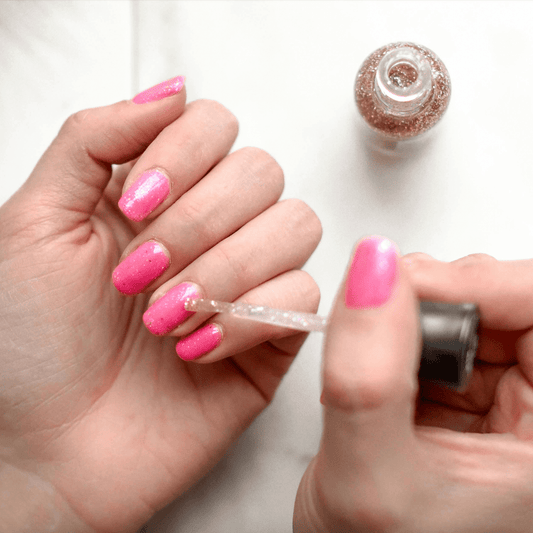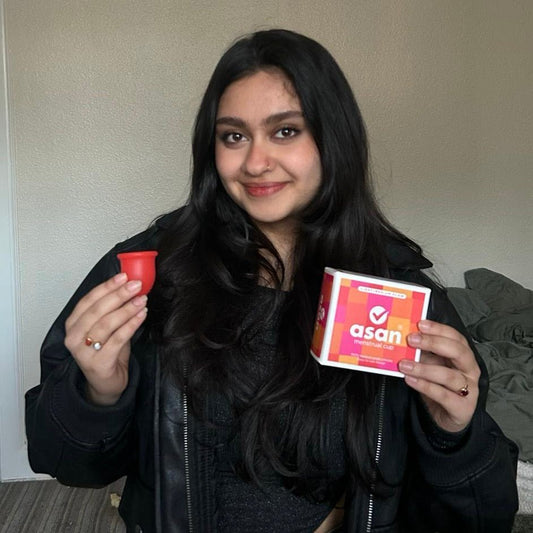your step-by-step guide to preventing leaks
The Asan menstrual cup is meant to be a life-changing period product, so we understand how frustrating it must be to experience leaks. Please be assured that while it may take a few attempts to master the art of using your cup, over time you should be able to use it without any leaks at all.
Below are some reasons why you may be experiencing leaks at the moment.
It is your first cycle using the cup!
It takes some practice to learn how to insert and remove your cup correctly. While you are still getting accustomed to the process, it is normal to experience leaks.
Make sure you carefully read the user guide that comes in the box and have a good look at our FAQ page. These resources are designed to make sure you have all the information you need for a worry-free period, so please take the time to familiarise yourself with them.
When you first use the cup, try not to do so in a hurry. Try using it in a relaxed setting (such as your bathroom at home) and spend some time practicing the different folds to find out which one works best for you.
During your first cycle, we advise you wear a pad or panty-liner as a backup. Once you get used to the process, the Asan cup is all you need.
The cup is still folded and has not opened up correctly.
When you insert the cup, it is important that it opens up completely and forms a seal against the walls of your vagina. This is what prevents leaks from taking place.
To know if your cup has opened up correctly, run a finger around it to make sure there are no dents or folds. If you prod it, it should feel resistant, as if a suction has formed. You should also feel some resistance if you gently tug on the ring.
If you are unsure whether your cup has opened up correctly, the best thing to do is to remove and re-insert it. Please try a few different folds to find the one that works best for your body. Once inserted, you can also gently rotate or twist the cup from its base to get rid of any dents or folds.
The cup is sitting in the wrong position.
Unlike tampons, which are pushed all the way up to your cervix, a menstrual cup is worn low in the vaginal canal. You may be experiencing leaks if you push it up too high. The cup should be entirely inside your body, but it should be worn as low as it can comfortably sit. It is fine if a little bit of the ring sticks out.

Another reason for leaks may be that your cup is inserted at the wrong angle. The vaginal canal is not vertical — rather, it runs backwards into your body at roughly 45 degrees. When inserting, make sure you angle the cup towards your tailbone rather than directly upwards.
To get the cup to sit in the right place, it may help to experiment with a few different positions while inserting. You could try squatting, standing with your legs apart or standing with one leg over the toilet seat. Over time, you will find the position that works best for your body.
The cup is overflowing.
If you tend to experience leaks a few hours after inserting the cup (rather than immediately), the cup may have filled up and be overflowing. This may happen especially if you experience heavy flow. Whilst getting used to your cup, you can check it every few hours to understand how quickly it fills up. This will enable you to remove and empty it in advance, so that you can avoid leaks from overflow.
You are using the wrong size.
The Asan menstrual cup comes in two sizes: light/medium flow and heavy flow. Our heavy flow cup is specifically designed not to leak for users who change pads/tampons every 2-6 hours. It is made from slightly firmer silicone, which is designed to pop open easily and form a firm seal with the walls of your vagina.
If you are using our light/medium-flow cup and experiencing persistent leaks, it may be the case that you need to switch to our heavy-flow size.
Still experiencing leaks?
If you’ve used the Asan cup for three cycles and are still experiencing leaks, please get in touch with our team. We will do everything in our power to help solve the problem. Where appropriate, we may offer you a replacement cup in a different size.













